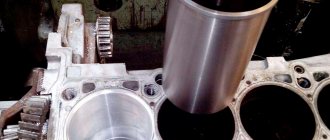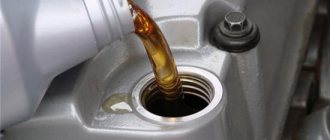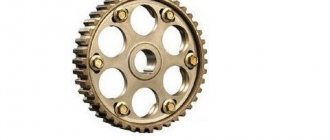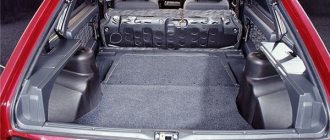The VAZ-415 car with a rotary engine was initially perceived as a comic experiment. According to the developers, the “nine” with such an engine could outrun a Mercedes at a speed of 200 km/h. Nevertheless, there is some part of the truth in this. The power unit in question surpassed all standard modifications of the domestic automotive industry in terms of dynamic and speed parameters. Let's figure out what the advantages and differences of this device are from conventional internal combustion engines.
general information
For the first time in Russia, the VAZ-415 with a rotary engine appeared in 1996 on the basis of the VAZ-2109. The vehicle differed from its competitors in its increased power performance. An experimental 140 horsepower engine accelerated the car to 100 km/h in just eight seconds. At the same time, the speed threshold was about 200 km/h.
The capacity of the fuel tank is 39 liters, fuel consumption has increased noticeably. A full refueling was enough for a trip from Moscow to Smolensk and back. The fact that the car did not go into mass production is explained by its solid “appetite”, as well as its high cost. After the starting prototype, manufacturers released two more copies: versions with 150 and 250 “horses”. The increased dynamics in practical terms did not provide anything useful. The engine, boosted in all respects, became completely unusable after 40 thousand kilometers.
Reliability, weaknesses, maintainability
Reliability
Despite many unfinished aspects, the VAZ-415 is considered a reliable engine. This was clearly expressed on one of the cut forums from Novosibirsk. He writes: “... the engine is simple, relatively reliable, but the problem is with spare parts and prices...”.
An indicator of reliability is the mileage before major repairs. The resource declared by the manufacturer was rarely maintained, but there were interesting facts in the history of the motor.
Thus, the magazine “Behind the Wheel” describes the situation with the rotary engine installed on the RAF. It is emphasized, “... the engine finally wore out after 120 thousand km, and the rotor was virtually beyond repair...”.
Private car owners also have experience in long-term operation of internal combustion engines. There is information that the unit provided a mileage of over 300 thousand km without major repairs.
The second main factor indicating reliability is the safety margin. The VAZ-415 has an impressive one. Just one installation of an injector increases engine power by more than 2.5 times. The interesting thing is that the engine can easily withstand high speeds. So, spinning up to 10 thousand revolutions is not the limit for it (operational - 6 thousand).
The AvtoVAZ design bureau is constantly working to improve the reliability of the unit. Thus, the problem of increasing the efficiency of bearing units, gas and oil seals, and warping of the metal of housing units due to their different heating was solved.
The VAZ-415 is characterized as a reliable engine, but only if it is cared for promptly and thoroughly.
Weak spots
The VAZ-415 has the weaknesses of its predecessors. First of all, car owners are not satisfied with the high oil and fuel consumption. This is a feature of a rotary engine, and you have to come to terms with it.
On this occasion, car enthusiast wooden_goblin from Makhachkala writes: “... it’s true that the oil consumption is almost a liter per 1000, and the oil needs to be changed every 5000, and spark plugs every 10,000... Well, spare parts are manufactured in only two factories...”.
Phillip J echoes his sentiments: “...the most unpleasant thing is not frugality. The rotary V8 consumes 15 liters of gasoline per 100 km. On the other hand, the engine, as its developers claim, doesn’t care what it’s powered by: be it 98 or 76...”
The special design of the combustion chamber does not allow all surfaces of the internal combustion engine to have the same temperature. Therefore, inattentive and aggressive driving often leads to overheating of the unit.
The high level of toxicity of exhaust gases is of no small importance. For a number of reasons, the engine does not comply with environmental standards adopted in Europe. Here we must pay tribute to the manufacturer - work in this direction is underway.
The process of servicing the motor causes great inconvenience. Most service stations do not accept such internal combustion engines. The reason is that there are no specialists working on rotary engines.
In practice, there are only two car services where you can properly service or repair the unit. One is located in Moscow, the second in Tolyatti.
Maintainability
The VAZ-415 is simple in design, but not one that can be repaired in any garage. Firstly, there is a certain problem with finding spare parts. Secondly, the unit reacts very painfully to the quality of parts. The slightest discrepancy leads to its failure.
One of the available options is to purchase a contract engine. It’s easy to find sellers of rotary internal combustion engines on the Internet. At the same time, you need to be prepared for the fact that the cost of these internal combustion engines is quite high.
Despite the promise of rotary engines, production of the VAZ-415 was discontinued. One (and perhaps the most important) of the reasons was the high cost of its production.
Historical facts
The unique VAZ-415 unit had a rotary engine, which was of interest to Soviet officials back in 1974. Trying to improve momentum in the automotive industry, the government decided to take a big risk. A special design bureau is being created at the plant in Togliatti, the main task of which is to create serial Wankel engines, as rotary units were also called.
Since VAZ models initially copied the Italian Fiat, the engineers in the new version decided to take the Mazda engine as a basis. Domestic injection developments fell into oblivion, although this was the wrong decision, as it turned out later. Soviet officials themselves began negotiations directly with Wankel on the issue of acquiring a license. They were unsuccessful because the designer asked for a huge fee. However, some technologies have been successfully copied.
The pioneer model in this segment was the VAZ-311 with 65 horsepower. The pilot series was released only five years later. 50 copies of the VAZ-415 rotary engine rolled off the assembly line. The models sold successfully among plant workers and government bigwigs.
Advantages and disadvantages
The converted movement of a reciprocating nature is completely absent in a rotary engine. Pressure is generated in those chambers that are created using the convex surfaces of the triangular rotor and various parts of the housing. The rotor performs rotational movements with the help of combustion. This can reduce vibration and increase rotation speed. Due to the increased efficiency that results from this, the rotary engine is much smaller in size than a conventional piston engine of equivalent power.
A rotary engine has one main component among all its components. This important component is called a triangular rotor, which rotates inside the stator. All three vertices of the rotor, thanks to this rotation, have a constant connection with the inner wall of the housing. With the help of this contact, combustion chambers are formed, or three closed-type volumes with gas. When the rotor rotates inside the housing, the volume of all three formed combustion chambers changes all the time, reminiscent of the actions of a conventional pump. All three side surfaces of the rotor act like a piston.
Inside the rotor is a small gear with external teeth, which is attached to the housing. The gear, which is larger in diameter, is connected to this fixed gear, which sets the very trajectory of the rotational movements of the rotor inside the housing. The teeth in the larger gear are internal.
Due to the fact that the rotor is connected eccentrically to the output shaft, the rotation of the shaft occurs in the same way as a handle would rotate a crankshaft. The output shaft will rotate three times for each rotor revolution.
The rotary engine has the advantage of low weight. The most basic of the rotary engine blocks is small in size and weight. At the same time, the controllability and performance of such an engine will be better. It has less weight due to the fact that there is simply no need for a crankshaft, connecting rods and pistons.
The rotary engine has dimensions that are much smaller than a conventional engine of the same power. Thanks to the smaller engine size, handling will be much better, and the car itself will become more spacious, both for passengers and the driver.
All of the parts of a rotary engine perform continuous rotational movements in the same direction. Changing their movement occurs in the same way as in the pistons of a traditional engine. Rotary engines are internally balanced. This leads to a decrease in the vibration level itself. The rotary engine's power feels much smoother and more even.
The Wankel engine has a special convex rotor with three edges, which can be called its heart. This rotor performs rotational movements inside the cylindrical surface of the stator. The Mazda rotary engine is the world's first rotary engine that was developed specifically for mass production. This development began back in 1963.
Peculiarities
The updated engine did not gain much popularity, since it had only a Japanese lining, and the internals quickly failed. The units had to be changed to piston analogues, in general the idea failed.
Nevertheless, the engine received an unexpected second life. After the next proposal, the plant began production of the VAZ-415 two-section rotary engine with a capacity of 120 horsepower. The resurrected domestically produced unit became so attractive that they began to order it for sports cars and water transport. Vehicles with the specified power units won prizes, far ahead of vehicles with standard pistons. Most likely, it was this fact that became the reason for the ban on the production of this engine. The next attempt at resuscitation occurred after the collapse of the Union in 1996, as mentioned above.
RPD in the USSR and after
Rotary engine VAZ 2109
Let's start with the fact that in 1996, the VAZ 2109 with a rotary engine began to be produced in our country. It was a car with increased power. Under the hood, a 140-horsepower rotor engine rumbled, accelerating the beloved “nine” to 100 km/h in just 8 seconds, and the maximum speed was 200 km/h. That's where the rumors about racing with Mercedes come from. As for the fuel tank, its volume was 39 liters, since the appetite of such a VAZ 2109 was simply voracious. Thanks to the huge tank, it was possible to travel from the capital to Smolensk and return back.
Note. The huge fuel consumption, in some way, explains the unpopularity of the VAZ 2109 with a rotary power unit.
Time does not stand still. After the release of the first “nine” with such an engine, manufacturers released two more versions: a 150 hp engine. and a forced modification developing 250 hp. Such huge dynamics did not yield anything meaningful. Only 40 thousand kilometers and the engine, crazy in terms of power characteristics, turned into junk.
Note. Another reason why the rotary “nine” did not take root in Russia is the high cost of the car and the huge costs of its maintenance.
A little history
Interesting Facts:
- The rotary engine or RPD came into the spotlight of the Soviet government back in 1974, a disastrous year for the country. In order to somehow increase turnover, socialist economy goes all-in. A special design bureau called RPD is being created at VAZ, the goal and main task of which is the serial production of “Wankel units”;
- Since the VAZ was initially planned as a copy of Western technologies, in particular Fiat, the new design bureau decided to reproduce the Mazda engine. The government, roughly speaking, didn’t give a damn about ten years of work by Soviet engineers (see VAZ 2109: injector repair - how to do it?) and they were consigned to oblivion, as it turned out in vain;
- At first, Soviet officials conducted long negotiations with Wankel himself regarding the purchase of a license, which were unsuccessful due to budget limitations (according to rumors, Wankel requested a huge amount). Still, some advanced technologies have been successfully adopted. The first 1-section VAZ 311 engine was put into production. It had a power of 65 hp, but that was just the beginning;
- The pilot batch was released, oddly enough, only after 5 years. 50 samples of the rotary motor have already rolled off the assembly line. They instantly disperse among the auto industry workers themselves, so to speak, inside the kitchen. Well, maybe the top government officials also suffered something, not without it.
VAZ 2109 with a rotary piston engine
Note. True, this did not help the engine to take root, since it only adopted an external resemblance to the Japanese one, but its interior was not very good - it soon began to crumble like a Soviet.
- I had to replace all the units with conventional piston ones. The idea failed;
- But unexpectedly salvation comes from unexpected places. The RPD design bureau, whose employees have already been blacklisted and would soon be reprimanded at a closed congress of auto industry workers, receives an offer from the intelligence services. The “Chekists” were not at all interested in fuel consumption and engine life, but the power indicators were very much so;
- Having received the offer, the plant immediately launched production of a 2-section RPD. The power of this engine is 120 hp. Installed on a VAZ 2101 Arkan (special production);
- The revived RPD was liked so much that they began to order it for sports and water transport. Cars and boats equipped with such an engine won only prizes, leaving vehicles with conventional piston engines far behind. Apparently, this was the reason for the ban on the release of RPD in the future. Only after the collapse of the USSR did the VAZ 2109 manufacturers take up a new attempt, as described above.
Rotary engine for VAZ 2109
This is the story of the rotary internal combustion engine in the USSR era.
Advantages
The VAZ-415 rotary engine, the photo of which is presented below, has become an excellent alternative to a forced engine. Among the advantages:
- stable power indicator throughout the entire operating range;
- huge potential for chip tuning;
- high efficiency;
- speed up to 10,000 rotations per minute.
The operating principle of the unit in question differs from a standard internal combustion engine. First of all, this is due to the presence of a rotor, which performs the duties of a connecting rod and piston. The incoming energy from fuel combustion provokes the rotation of the shaft at high speed. Inlet and outlet occur in a single compartment, the inside of which resembles a capsule. The rotor was mounted on a shaft and was firmly engaged with a gear, which is connected to the stator.
Rotary aggregate and everything connected with it
This motor has constantly attracted and is attracting maximum attention not only in the vastness of our Motherland. And this is not surprising: the design of such a power unit is very simple, and the characteristics seem to be under the hood of not one, but two motors, but, as in our case, this unit has not taken root anywhere. The creator of such a motor is called Wankel, who managed to come up with this design back in 1919. Wankel was German and at the age of 17 he created a miracle. How he managed this remains a mystery. DKM or “machine with rotating pistons” is the name given to the first car with a rotary unit, the first patent for which Wankel received in 1929.
Operating principle
Rotary engine in the VAZ 2109 and its operating principle
The rotary engine today is called an excellent alternative to a highly boosted engine. This unit has the following advantages:
- Constant power throughout the entire range of engine operation;
- Huge potential for boosting (chip tuning);
- Incredibly high efficiency (with 1 liter of working volume it is possible to squeeze out about 110 hp even without chip tuning);
- Although in the case of the VAZ 2109 the engineers were unable to achieve efficiency, the rotary engine, in fact, can consume relatively little (there is a chance to repeat the experience with the “nine”);
- Cars with a rotary unit are capable of developing high speeds (up to 10,000 per minute).
The operating principle of this miracle unit is as follows:
- It is strikingly different from the operation of a piston internal combustion engine, as this is due to design features. Among the main differences is the rotor itself, which plays both the role of a piston and the role of a connecting rod;
- In such units, the entire crankshaft mechanism is reduced to only the rotor and shaft. The fuel energy forces the shaft to rotate at high speed.
Interesting. It is noteworthy that fuel supply, shaft rotation and the rest occur in one block, which is both the combustion chamber and the timing belt.
- All important processes take place in a single block: intake and exhaust;
- The block itself is shaped like a capsule from the inside. In science, this form has its own name - epitrochoid;
- There is a rotor mounted on the shaft. It is firmly coupled to the gear, which in turn is connected to the stator.
Wankel and its engine
Note. You should know that the rotor is much larger than the stator, but despite this, it rotates easily with the gear.
- The rotor has a triangle shape. Moving along the inner surface of the block, the triangle (or rather, each of its ends) cuts off a certain amount of space;
- As for the piston rings, in a rotary unit their function is performed by special plates that are pressed against the walls of the block by band springs, gas pressure and centrifugal forces;
- The design of the Wankel engine is devoid of a complex timing belt, which greatly simplifies it;
- Due to the absence of friction losses (as we remember, this motor does not have many KVM parts - see above), it is possible to generate more power;
- In a rotary unit, for one full revolution of the rotor there are as many as three working cycles.
Note. One of the disadvantages of a rotary engine is its large appetite, which is explained, in particular, by the fact that the combustion chamber at the moment of the compression stroke is too long and the fuel does not have time to completely burn out. It is in order to combat this, to increase efficiency, that two spark plugs are installed on such engines. They fire alternately, igniting the fuel on both sides. Thanks to such measures, invented quite recently, it was possible to significantly increase the performance of the rotary unit in terms of efficiency (note to VAZ 2109 engineers).
So far, all this looks good only on paper. Using the example of the VAZ 2109 and other car models with a rotary engine, it becomes clear that success in real life is still far away. There are many cars with this engine scattered all over the world, in different parts of it. A few of them are still on the move, but most (lucky ones) are kept in museums or private collections. Many models with engines from the 60s-80s can be found in landfills.
History of the rotary engine
The shortcomings of such a rare engine today will immediately surface and discourage an ardent agitator for the introduction of a rotary internal combustion engine into automobile production as soon as we imagine the following situation.
The owner of a “nine” with a rotor found himself in an unpleasant situation: his engine overheated. What will he do? The answer is clear: rush around the city and look for specialists, rare spare parts and parts. On the other hand, the rotary engine has a future. Nobody took him away. The Wankel engine has the green light and engineers around the world will have to work hard to improve the design and eliminate most of its shortcomings. Then an ordinary piston internal combustion engine will turn out to be a weak competitor in front of a powerful rotary unit, destined for oblivion. But today it’s too early to think about it.
RPD operation scheme
Device
The rotary power unit of the VAZ-415 is made in the shape of a triangle. When moving inside the block, each end of the structure is separated by a certain amount of space. In this engine, the role of piston rings was played by special plate elements, pressed to the walls using belt-type springs, centrifugal force and exhaust gas pressure.
The design of the Wankel internal combustion engine does not include a timing belt, which significantly simplifies the design of the device. Since friction losses in this unit are minimal, it was possible to achieve a significant increase in power. Three working cycles were carried out during one full revolution.
The disadvantages of rotary engines include high fuel consumption. This is due to the fact that the combustion compartment during the compression stroke is too long, which does not allow the gasoline to burn out completely. To level out this drawback, they began installing two spark plugs on the engines, firing alternately. This approach made it possible to increase the efficiency of the updated modifications.
Components and operating principle
The design of the RPD type engine is extremely simple and compact. A rotor is installed on the axis of the unit, which is firmly connected to the gear. The latter engages with the stator. The rotor, which has three sides, moves along an epitrochoidal cylindrical plane. As a result, the changing volumes of the working chambers of the cylinder are cut off using three valves. Sealing plates (end and radial type) are pressed against the cylinder under the influence of gas and due to the action of centripetal forces and band springs. This results in 3 isolated chambers of different volumetric dimensions. Here the processes of compression of the incoming mixture of fuel and air, expansion of gases, exerting pressure on the working surface of the rotor and clearing the combustion chamber of gases are carried out. The circular motion of the rotor is transmitted to the eccentric axis. The axis itself is located on bearings and transmits rotational torque to the transmission mechanisms. In these motors, two mechanical pairs operate simultaneously. One, which consists of gears, regulates the movement of the rotor itself. The other converts the rotating movement of the piston into the rotating movement of the eccentric axis.
Rotary piston engine parts
Operating principle of the Wankel engine
Using the example of engines installed on VAZ cars, the following technical characteristics can be mentioned: - 1.308 cm3 - working volume of the RPD chamber; — 103 kW/6000 min-1 – rated power; — 130 kg engine weight; — 125,000 km – engine life before its first complete overhaul.
Characteristics of VAZ-415
Brief parameters of the Wankel engine:
- number of sections - 2 pieces;
- power indicator - 140 hp. With.;
- unit weight - 113 kg;
- working chamber volume - 1.3 cubic meters. dm;
- overall dimensions - 570/535/665 mm;
- working life before major repairs - 125 thousand km.
It is worth noting that fuel supply, shaft rotation and other operating operations occur in a single unit, which is the combustion compartment and timing section.
Operating principle of a rotary engine
The rotary motor operates according to a scheme that differs from the technology characteristic of a standard internal combustion engine with pistons as the main moving element. In addition, power units have different designs.
By analogy with a piston engine, the operating principle of the RPD is based on the conversion of energy obtained as a result of the combustion of the air-fuel mixture. In the first case, the pressure created in the cylinders when burning fuel forces the pistons to move. The reciprocating movements of the connecting rod and crankshaft are converted into rotational movements, which cause the wheels to spin.
The rotor moves in the inner cavity of the oval capsule, transmitting power to the clutch and gearbox. Thanks to its triangular shape , it squeezes out fuel energy, directing it through the transmission to the wheel system. A prerequisite is that alloy steel is used as the material.
Inside the cylinder where the rotor is located, the following processes occur:
- the air-fuel mixture is compressed;
- another dose of fuel is injected;
- oxygen comes in;
- the fuel ignites;
- burnt elements are directed to the outlet.
The triangular rotor is fixed to a special mechanism. When the engine starts, it performs specific movements, not rotating, but as if running inside an oval capsule.
Due to its shape, it forms 3 isolated chambers in the body.
The following processes are observed in them:
- to the first cavity through the inlet window and oxygen is sucked in, forming an air-fuel mixture when mixed;
- in the second compartment compression and ignition occur;
- combustion products are forced into the outlet from the third chamber .
RPD device diagram
The design of the RPD includes the following elements:
- A rotor with 3 convex edges that act as a piston. Due to the recesses, the rotation speed increases, creating more space for the air-fuel mixture.
- Metal plates attached to the tops of each side. Their purpose is to form cavities in the housing where the working processes of the power plant take place.
- 2 metal rings on the edges of the rotor serve to form chamber walls.
- In the center of the structure there are 2 large wheels with a large number of teeth, rotating around gears of a smaller diameter. The gear train is connected to a drive device mounted on the output shaft. The direction and trajectory of movement inside the chamber depend on this connection.
- Rotor housing. It is made in the shape of a conditional oval. This configuration ensures constant contact of the vertices of the triangle with the walls of the capsule, creating 3 isolated volumes of gas.
- Injection and exhaust windows. They have no valves. The inlet is connected to the fuel supply system, and the outlet is connected to the exhaust pipe.
- Output shaft with eccentric design. There are special cams on it, offset relative to the center line. A separate rotor is placed on each of these protrusions. Due to the asymmetrical installation, there is an uneven distribution of pressure force. This leads to the generation of torque, which causes stable operation of the power plant based on shaft speed.
5 main layers, fastened around the circumference with long screws, make up the standard design of a two-rotor engine. This creates conditions for free circulation of coolant within the system. The moving parts, represented by 2 rotors and an eccentric output shaft, are located between 2 stationary sections.
Power and resource
Compared to a standard internal combustion engine , the rotary unit is characterized by greater specific power, which is measured in hp/kg . This is explained by the lower mass of moving parts that make up the RPD . The rationale is the absence of a gas distribution mechanism, valve system, crankshaft and connecting rods.
In addition, the single-rotor engine converts the energy of fuel combustion into rotational motion over ¾ strokes of the operating cycle. For piston engines this figure is reduced to ¼.
As a result, with a cylinder capacity of 1.3 liters, a modern RPD develops power up to 220 hp . And if the basic design is supplemented with turbine charging, then up to 350 hp .
Until 2011, only Japanese industrialists of the Mazda concern produced cars with rotary engines. And then they removed the unit from production. The probable reason is the reduced service life of the power plant. Before the first major overhaul, vehicles travel only 100 thousand km. With a careful driving style and careful handling, the mileage increases to 200 thousand km.
The vulnerable link is the rotor seals, which suffer from overheating and high loads. In addition to these factors, they are negatively affected by detonation and wear of bearings located on the eccentric shaft.











